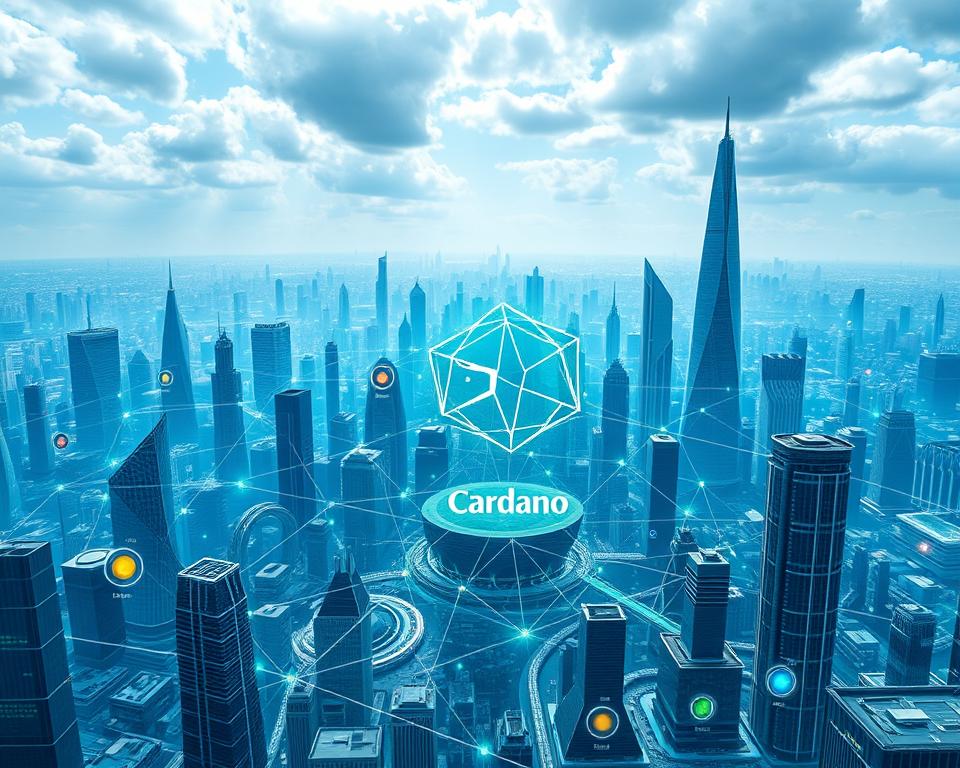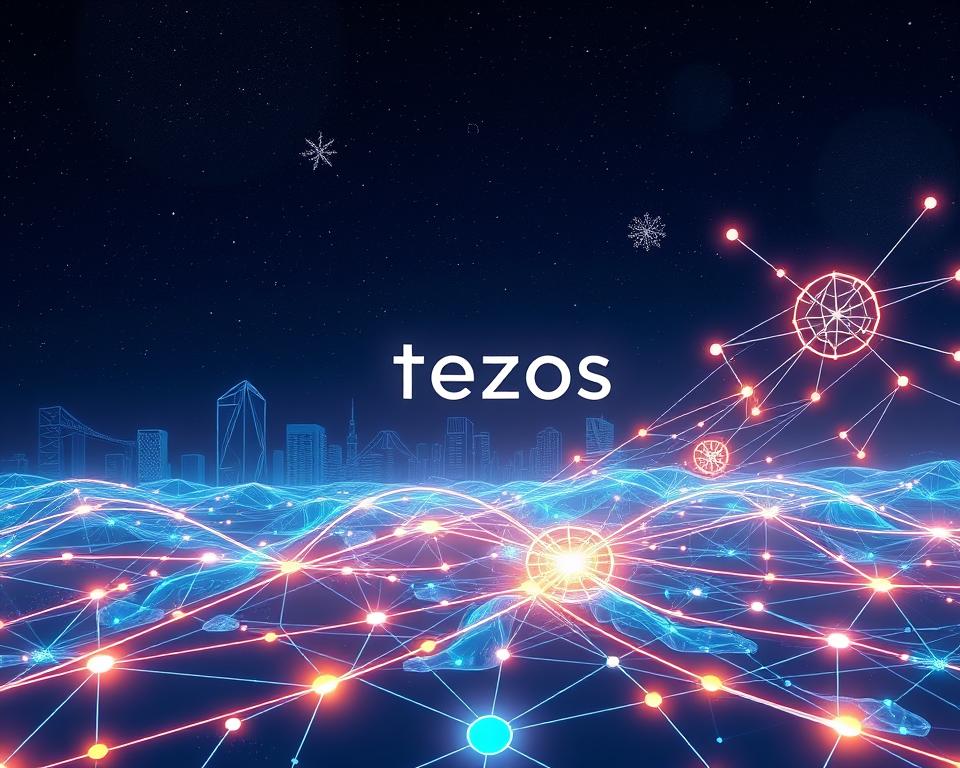The blockchain revolution has changed the digital world. It has brought us decentralized networks, secure cryptocurrencies, and smart contracts. As we look to 2025, the blockchain world is ready for more growth. Many platforms are competing for attention from businesses, developers, and users.
This article will look at the top 15 blockchain platforms for 2025. We’ll see what makes them special, their uses, and their latest tech breakthroughs.
Table of Contents
Key Takeaways
- Blockchain technology is transforming industries with decentralized networks, secure cryptocurrencies, and innovative smart contracts.
- The top 15 blockchain platforms for 2025 offer a wide range of features and capabilities to cater to diverse needs.
- These platforms are leading the way in terms of performance, scalability, interoperability, and sustainability.
- Businesses and developers can leverage these blockchain solutions to build cutting-edge decentralized applications and drive innovation.
- Understanding the strengths and use cases of the top blockchain platforms is crucial for making informed decisions in the rapidly evolving digital landscape.
Understanding Blockchain Platforms and Their Evolution
Blockchain technology has changed how we handle digital transactions and data. It’s a system that uses cryptography to keep records safe and accurate across many computers. This way of managing data has big impacts on tech, from money to supply chains.
The Role of Blockchain in Modern Technology
Blockchain is driving innovation in many fields. It makes new business models possible and changes how we use digital systems. Its security, openness, and unchangeable nature make it great for things like digital money, smart contracts, and IoT.
Key Components of Blockchain Platforms
- Distributed Ledger Technology: Blockchain uses a system where data is copied and shared among many nodes.
- Consensus Mechanisms: It uses algorithms like Proof-of-Work or Proof-of-Stake to check transactions and keep the network safe.
- Cryptography: Blockchain uses cryptography to keep data safe and stop unauthorized changes.
- Decentralization: Blockchain networks don’t have one central point, making them open and less likely to be manipulated.
Evolution from Bitcoin to Modern Solutions
Blockchain has grown a lot since Bitcoin. New platforms have come up, each with special features like better speed, less energy use, and smarter contracts. These new solutions aim to fix old problems, opening up new possibilities for tech.
| Platform | Key Feature | Use Case |
|---|---|---|
| Ethereum | Smart Contracts | Decentralized Applications (dApps), DeFi |
| Binance Smart Chain | High-Speed Transactions | DeFi, Gaming, Supply Chain |
| Solana | High-Performance | DeFi, NFTs, Gamefi |
Platforms like Cardano, Polkadot, and Avalanche are leading the way. They keep improving to meet the needs of our digital world.
Ethereum: The Pioneer of Smart Contracts
The Ethereum network is a game-changer in the blockchain world. It introduced smart contracts, which are digital agreements that run on their own. This has changed how Ether (ETH) and dApps work on the Ethereum Virtual Machine (EVM).
Ethereum lets developers make and use complex dApps. These apps can handle all sorts of transactions and processes automatically. This has opened up many uses, like DeFi and NFTs.
One big plus of Ethereum is that it lets developers innovate freely. They can make and use dApps without needing permission from anyone. This has led to a wide range of Ethereum apps, each with its own special features.
But Ethereum’s growth has also brought problems, like high gas fees and network congestion. To fix these, the Ethereum community is working on Ethereum 2.0. This upgrade aims to make the network better, faster, and more sustainable.
“Ethereum has the potential to be the world’s first global, decentralized computer.” – Vitalik Buterin, Co-founder of Ethereum
Ethereum keeps leading the blockchain revolution. It shows the power of smart contracts and what they can do for technology’s future.
Binance Smart Chain: Combining Speed with Affordability
The BNB Chain is a big player in blockchain tech, solving Ethereum’s scalability problems. It offers fast transactions and low fees. This makes it great for DeFi apps and more.
BNB Chain Architecture
The BNB Chain’s design makes for a smooth user experience. It uses a Proof-of-Staked-Authority (PoSA) system. This is faster and cheaper than traditional Proof-of-Work (PoW).
This setup lets the BNB Chain handle thousands of transactions per second. It’s perfect for many DeFi and blockchain apps.
Benefits for DeFi Applications
The BNB Chain is great for DeFi because of its low fees and high speed. It makes it easier for more people to join DeFi. This leads to more innovation and use.
It also works well with other blockchain networks. This makes DeFi apps even more powerful and widespread.
Integration Capabilities
The BNB Chain is easy to connect with many dApps and services. Its low transaction fees and strong setup attract developers. This has helped the BNB Chain grow fast.
Now, it has lots of DeFi projects, decentralized exchanges, and other blockchain solutions.
The BNB Chain is a strong choice for the future of blockchain. It offers speed, affordability, and easy integration. It’s perfect for businesses, developers, and users wanting to use decentralized tech.
Solana: High-Performance Blockchain Solution
Solana is a standout blockchain platform, known for its high-throughput abilities and Proof of History consensus. This tech makes Solana a top player in the fast-changing Solana ecosystem.
Solana can process transactions super fast, aiming for over 50,000 per second. Its Proof of History consensus is key. It uses a decentralized clock to verify events without long negotiations.
The SOL token, Solana’s native crypto, is gaining fans fast. Solana’s ecosystem is growing, with dApps in finance, NFTs, and more.
Enterprises and developers are taking notice of Solana’s speed and tech. They see its potential for critical apps and blockchain innovation. As Solana’s ecosystem grows, it’s set to shape the decentralized future.
Cardano: Scientific Approach to Blockchain
Cardano is a decentralized blockchain platform that stands out. It’s built on solid academic research and peer-reviewed studies. This makes the ADA token and the Ouroboros protocol very powerful.
Proof-of-Stake Implementation
The Ouroboros protocol is at the heart of Cardano. It’s a Proof-of-Stake (PoS) algorithm that’s been well-studied. It’s designed to be more energy-efficient and scalable than Proof-of-Work (PoW) used by Bitcoin and Ethereum.
Smart Contract Capabilities
Cardano’s Plutus platform is all about making smart contracts better. It focuses on security and scalability for decentralized apps (dApps). The platform’s design and testing methods ensure smart contracts are safe and reliable.
Sustainability Features
- Cardano is all about being sustainable. Its scalability and energy-efficient consensus mechanism make it great for developing countries.
- The platform’s academic research-driven approach and focus on accessibility could help more people use blockchain. This is especially true in areas with limited tech and expertise.
Cardano’s scientific method, strong Proof-of-Stake protocol, smart contract features, and focus on sustainability make it a top player in blockchain.
Top 15 Blockchain Platforms to Use in 2025
Blockchain technology is growing fast, and so are the platforms available. We’ll look at the top 15 blockchain platforms for 2025. They offer different features, uses, and are widely adopted, giving businesses and developers many choices.
When picking a blockchain platform, consider its scalability, speed, and consensus mechanisms. Also, look at its smart contract abilities and ecosystem support. Knowing each platform’s strengths and weaknesses helps you choose the right one for your projects.
Top 15 Blockchain Platforms:
- Ethereum
- Binance Smart Chain
- Solana
- Cardano
- Polkadot
- Avalanche
- Tezos
- Algorand
- Hedera
- Cosmos
- Near Protocol
- Fantom
- Celo
- Polygon
- Harmony
Each platform has unique features and uses, meeting the needs of the growing blockchain world. Keeping up with the latest in blockchain is key to making sure your projects use the best platforms.
Understanding the strengths and limits of these top platforms helps you make smart choices. As blockchain tech grows, so will the options for developers and businesses, opening up new chances for innovation and growth.
Polkadot: Connecting Multiple Blockchains
Polkadot is a unique platform in the blockchain world. It aims to change how different blockchain networks work together. This platform makes it easy to share data and assets across the crypto world.
Parachain Technology
Polkadot’s core is its parachain technology. Parachains are separate blockchain networks linked to the Polkadot relay chain. This setup lets developers create special blockchains for different needs.
Thanks to the substrate framework, making and using parachains is easy. This leads to a network of diverse blockchains working together.
Cross-Chain Compatibility
Polkadot is great at making different blockchain networks talk to each other. It lets data and DOT tokens move between networks. This breaks down barriers that have held back decentralized tech.
This connection opens up new chances for working together in the Web3 world. It’s a big step forward for blockchain.
Governance Structure
Polkadot’s governance is all about being open and community-led. It has a strong system for making decisions on the blockchain. This lets DOT token holders help decide on changes and how resources are used.
This way, the community gets to help guide Polkadot. It makes sure the network keeps growing and meets the needs of its users.
Polkadot is key to the future of blockchain. It connects different networks and lets them work together. Its unique setup and community focus make it a great place for developers and users to explore blockchain’s potential.
Avalanche: Fast, Low-Cost, and Eco-Friendly
In the world of blockchain, Avalanche stands out. It offers a unique way to make transactions fast, cheap, and good for the planet. This platform has caught the eye of DeFi and NFT fans because of its speed and ability to grow.
The secret to Avalanche’s success is its Avalanche consensus. It’s a new way to agree on transactions that’s fast and cheap. This makes it popular with developers and users.
Avalanche’s subnet architecture is another big plus. It lets people create special blockchain networks for different needs. This means Avalanche can grow and adapt in many ways.
The AVAX token is key to Avalanche. It’s used for everything from buying things to helping the network grow. This makes it a strong and safe way to be part of Avalanche.
Avalanche also cares about the planet. It uses a special way to agree on transactions that’s better for the environment. This makes it a greener choice for blockchain projects.
As more people look for blockchain solutions that are fast, cheap, and green, Avalanche is leading the way. Its strong design, flexible subnets, and focus on the environment make it a game-changer in blockchain.
Tezos: Self-Evolving Blockchain Technology
Tezos is a standout in the blockchain world. It’s a self-evolving platform that gets better over time. Unlike other blockchains, Tezos doesn’t need hard forks for updates. It has a unique on-chain governance model that lets the community vote on changes.
On-Chain Governance
Tezos’ governance system lets bakers – token holders – make decisions. They can suggest upgrades, discuss them, and vote on whether to adopt them. This way, Tezos can change itself to meet the needs of its users and the wider blockchain world.
Development Framework
Tezos uses the Michelson programming language for its development framework. This language supports formal verification, a strict process to check smart contracts’ correctness and security. This focus on formal verification makes Tezos a top choice for developers who need trust and reliability in their applications.
The XTZ token is at the heart of Tezos. It’s used for governance and staking, known as baking. Bakers get XTZ tokens for their work, helping keep the Tezos ecosystem stable and growing.
Tezos is appealing to many industries because of its self-evolving nature, formal verification, and strong governance. It’s great for decentralized finance (DeFi) and enterprise applications that need top security and reliability.
Algorand: Pure Proof-of-Stake Protocol
Algorand is a top layer-1 solution in the blockchain world. It uses a special Pure Proof-of-Stake (PPoS) protocol. This protocol helps Algorand create a fast, safe, and open platform for many uses.
Algorand tackles the “blockchain trilemma” head-on. This challenge is about making blockchain networks fast, secure, and open at the same time. With PPoS, Algorand says it has solved these problems. It offers quick transactions, low fees, and a strong network.
Algorand is all about finance. It lets users create and trade ALGO tokens and ASA tokens. This makes it great for DeFi projects. It’s perfect for businesses and developers wanting to build new financial tools on a permissionless blockchain.
Algorand’s community is growing fast. It has projects like decentralized exchanges, lending platforms, stablecoins, and NFT marketplaces. Its ability to scale and low costs are attracting more users, especially big companies.
As blockchain keeps growing, Algorand stands out. Its unique consensus method and focus on solving big problems make it a strong choice. It’s a high-performance, secure, and eco-friendly blockchain solution.
Hedera: Enterprise-Grade Public Network
Hedera is changing the game in enterprise blockchain solutions. Its core innovation is Hashgraph technology. This technology aims to fix the problems of traditional blockchains.
Hashgraph Technology
Hedera uses a directed acyclic graph (DAG) instead of the usual blockchain structure. This makes its consensus process more efficient and scalable. The Hashgraph consensus service ensures fast and reliable transaction processing.
The HBAR token is key to Hedera’s network. It powers the network’s tokenization features. Businesses can use Hedera to create and manage digital assets, making financial and operational processes smoother.
Corporate Applications
Hedera has caught the eye of many corporations. It’s great for supply chain management and digital identity. Its Hashgraph technology and consensus service provide a secure, scalable, and cost-effective platform for various corporate needs.
The network is governed by a council of global organizations. This ensures the network’s integrity and governance. It’s a reliable and transparent public network for blockchain-based projects.
“Hedera’s enterprise-grade public network and Hashgraph technology are revolutionizing the way businesses approach blockchain-based solutions. The network’s focus on scalability, security, and corporate-friendly features make it a compelling choice for organizations seeking a cutting-edge platform to drive their digital transformation.”
Comparing Platform Features and Capabilities
The blockchain world is always changing. It’s key to know what each top platform can do best. This section helps you pick the right blockchain for your needs.
Ethereum leads with its smart contract tech and strong community. Binance Smart Chain is fast and cheap, perfect for DeFi. Solana is great for growing blockchain projects.
Cardano stands out for its green tech and smart money system. Polkadot connects different blockchains with its parachain tech. Avalanche is fast, cheap, and good for the planet, fitting many needs.



















